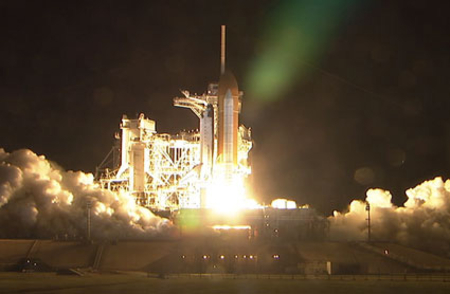This is an archive of information released in the past.
Disclaimer: It may contain broken links or outdated information. Some parts may not function in current web browsers.
*Visit https://humans-in-space.jaxa.jp/en/ for the latest information.

Mission
Space Shuttle Endeavour lifted off! (FD1)
Today, the Space Shuttle Endeavour roared into a midnight sky of Florida carrying Japan's first human-rated space facility, Experiment Logistics Module -Pressurized Section (ELM-PS), which is the first Kibo element to be delivered to the ISS, and the ISS's new robotic arm "Dextre" developed by Canadian Space Agency (CSA).
STS-123 is the 122nd space shuttle mission and the 25th to visit the station. Endeavour is making its 21st space flight and eighth trip to the station.
Endeavour successfully lifted off from Kennedy Space Center (KSC) at 1:28 a.m. March 11, 2008 CDT (3:28 p.m. March 11, 2008 JST), and achieved one of the major milestones in the Kibo assemblies on-orbit. Aboard the shuttle are JAXA astronaut Takao Doi and his six fellow crewmates.
When Endeavour was safely in space and its three main engines shut down, the external tank (ET) has been jettisoned. These sequences were taken with the cameras mounted on the underside of the orbiter. The shuttle crew also took the sequences with the hand-held digital video camera from inside the space shuttle. Because it was the night time launch, flash was used for the mounted cameras to take good shots of the ET and the orbiter.
Astronaut Doi and his fellow crewmates aboard Endeavour went to sleep at 7:28 a.m. (9:28 p.m. JST) today.
Before the sleep period, astronaut Doi powered up and checked out the space shuttle's robotic arm (SRMS). The SRMS will be used for the space shuttle's heat shield inspection scheduled on FD2, which will be tomorrow's major task.
Tomorrow (FD2), astronaut Doi will manipulate the SRMS and grapple the Orbiter Boom Sensor System (OBSS) to take a close look at the heat shield on the orbiter's wing leading edges and nose-cap. This will allow the engineers on the ground to obtain the data needed to assess the condition of the orbiter.
This morning, the JAXA Flight Control Team (JFCT) has commenced the Kibo operations control prior to the launch of Kibo's first element.
As of March 11, 2008, the JFCT will monitor and control Kibo operations around the clock in a three-shift per day until the day Kibo retires its on-orbit operations.
*All times are Japan Standard Time (JST)
| Copyright 2007 Japan Aerospace Exploration Agency | Site Policy |
